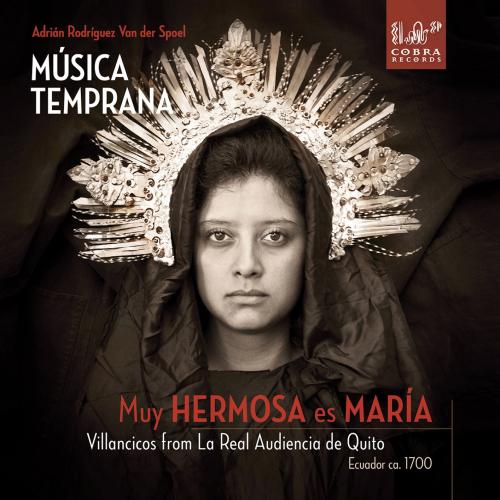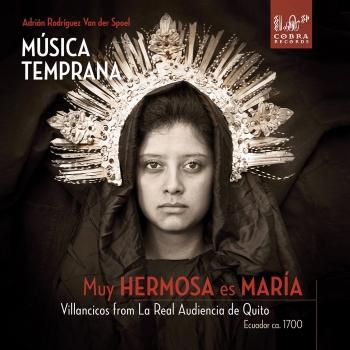
Muy hermosa es María Música Temprana & Adrián Rodriguez van der Spoel
Album info
Album-Release:
2019
HRA-Release:
03.05.2019
Label: CobraRecords
Genre: Classical
Subgenre: Vocal
Artist: Música Temprana & Adrián Rodriguez van der Spoel
Composer: Santiago de Murcia (1682-1735), Joseph Hortuño, Juan Bautista José Cabanilles (1644-1712), Manuel Blasco (1628-1696)
Album including Album cover Booklet (PDF)
- Manuel Blasco (1628 - 1696):
- 1 La Chacona me piden 04:43
- Anonymous:
- 2 Vamos al lugar amor 02:59
- 3 Ese viril con pan 03:48
- Santiago de Murcia (1673 - 1739):
- 4 Cumbees 03:19
- Anonymous:
- 5 Fuentes si naçéis 04:44
- 6 Celebre la tierra 04:34
- 7 Oigan que da 04:40
- Santiago de Murcia:
- 8 Zarangilleja 03:16
- Manuel Blasco:
- 9 De uno en uno vayan entrando 03:33
- Juan Cabanilles (1644 - 1712):
- 10 Paseos sexto tono, WSC 147 02:41
- Anonymous:
- 11 Muy hermosa es María 04:53
- 12 Sacro Sanctæ 01:55
- 13 Seguilda marineros 05:15
- Joseph Hortuño (1660 - 1722):
- 14 Vamos todos a ver 04:21
- Antonio José Estévez Aponte (1916 - 1988):
- 15 Tonada de Ordeño (Arr. A. Spoel) 03:05
Info for Muy hermosa es María
The loose papers discovered in the Archive of the Diocesan Administration of Ibarra by Jorge Isaac Cazorla in the north of Ecuador containing villancicos from the late 17century are the tip of the iceberg of an output which clearly must have been great. Everything within the historic centre of Quito, declared a World Heritage Site by UNESCO, with its 40 churches & 16 monasteries and more than 5000 heritage buildings points to a rich musical heritage. Sadly many of the musical archives have been pillaged or lost due to natural disasters, moves, carelessness and other factors.
The Ibarra works are religious vocal music with instrumental accompaniment. Except for the Latin prayer for seven voices Sacro Sanctæ, the other com- positions are villancicos in Spanish in the 17century Spanish tradition, with an unmistakable element of popular music. The religious metaphors used stereotyped characters speaking slang, making it easier for listeners at the time to understand and identify them. In the period when these works were sung (around 1700), the number of voices, complexity and length of villancicos began to increase and they continued to draw on popular genres, just as they had since the beginning of the Renaissance.
Little is known about the work of women during the colonial period as the patriarchal society has always focused on male composers. The Ibarra manuscripts support the idea of a rich musical life in the convents. The prolific literary activity in Quito makes it very plausible to say that many of the texts preserved were sung ánd written by nuns as the parts found at Ibarra speak constantly of women. It is a key element for Música Temprana that through this CD the anonymous women of the convents receive the recognition they deserve.
Música Temprana
No biography found.
Booklet for Muy hermosa es María










